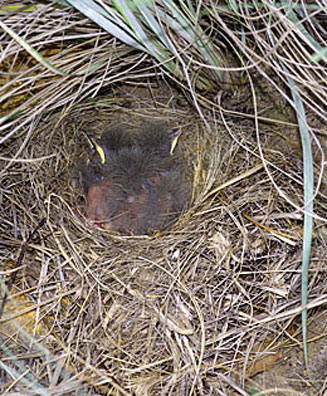|
Anthus similis (Long-billed
pipit)
Nicholsonse koester [Afrikaans]; Icelu, Icetshu (generic
terms for pipit) [Xhosa]; umNgcelekeshu, umNgcelu (generic terms for
pipit) [Zulu]; Tšase (generic term for pipits) [South Sotho];
Langsnavelpieper [Dutch]; Pipit ŕ long bec [French]; Langschnabelpieper
[German]; Petinha-de-bico-comprido [Portuguese]
Life
> Eukaryotes >
Opisthokonta
> Metazoa (animals) >
Bilateria >
Deuterostomia > Chordata >
Craniata > Vertebrata (vertebrates) > Gnathostomata (jawed
vertebrates) > Teleostomi (teleost fish) > Osteichthyes (bony fish) > Class:
Sarcopterygii (lobe-finned
fish) > Stegocephalia (terrestrial
vertebrates) > Tetrapoda
(four-legged vertebrates) > Reptiliomorpha > Amniota >
Reptilia (reptiles) >
Romeriida > Diapsida > Archosauromorpha > Archosauria >
Dinosauria
(dinosaurs) > Saurischia > Theropoda (bipedal predatory dinosaurs) >
Coelurosauria > Maniraptora > Aves
(birds) > Order: Passeriformes
> Family: Motacillidae > Genus: Anthus
Distribution and habitat
Occurs in isolated patches from India and the Arabian
Peninsula to West and East Africa, with another localised population from
south-western Angola to southern Africa. Here it is fairly common from the
western half of Namibia through to much of South Africa excluding the Kalahari
Desert, marginally extending into south-western Botswana. It generally prefers
rocky slopes and gullies in a wide variety of habitats including semi-arid
shrubland, grassland and lightly wooded areas; it may also occupy well-grazed
pastures and burnt fields and fynbos.
|
 |
|
Distribution of Long-billed pipit in southern Africa,
based on statistical smoothing of the records from first SA Bird Atlas
Project (©
Animal Demography unit, University of
Cape Town; smoothing by Birgit Erni and Francesca Little). Colours range
from dark blue (most common) through to yellow (least common).
See here for the latest distribution
from the SABAP2. |
Food
It mainly eats insects and other invertebrates, doing most
of its foraging on the ground, plucking food items from soil and grass stems. The following food items have been recorded
in its diet:
Breeding
- Monogamous, territorial solitary nester, with each male performing an
aerial display in which it ascends in an undulating, fluttering flight.
- The nest (see image below) is mainly built by the female, consisting of
an open cup of dry grass and plant stems and lined with finer grass and
rootlets. It is typically placed on a slope beneath a rock overhang, or
alternatively it can be wedged between a rock and dense grass tuft.
 |
|
|
Long-billed pipit nest with chick, Luneburg, South
Africa.[photo Warwick Tarboton ©] |
|
- Egg-laying season is from August-April, peaking from about
October-December.
- It lays 1-4 eggs stone-coloured or whitish eggs, densely spotted with
grey, brown and violet markings.
- The chicks are fed by both adults, leaving the nest after about 13-14
days. If the brood is approached by a predator the parents pretend to be
injured, so as to lure it away.
Threats
Not threatened.
References
-
Hockey PAR, Dean WRJ and Ryan PG 2005. Roberts
- Birds of southern Africa, VIIth ed. The Trustees of the John Voelcker
Bird Book Fund, Cape Town.
|
